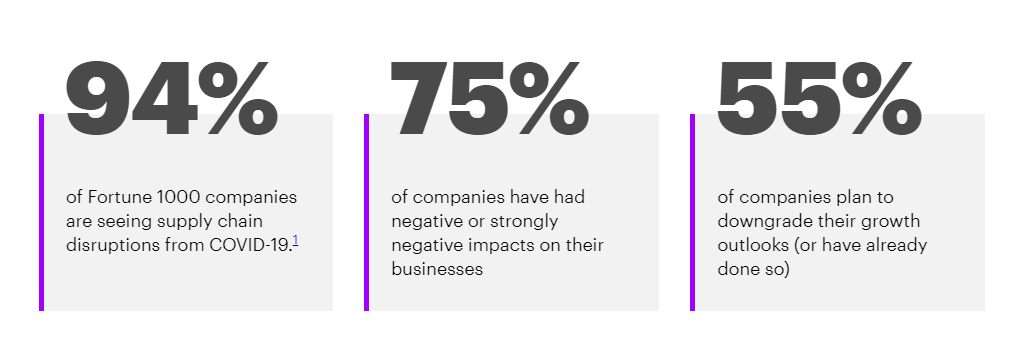
With all the upheaval that global supply chains have had to contend with, the value of supply chain optimization has never been more vital. Significant progress has been made over the last two years to respond to the weaknesses and issues exposed, but there is still much to be done regarding supply chain strategies and implementation. Approaching logistics with a focus on omnichannel supply chain options may be the best option to speed recovery.
As highlighted by McKinsey & Company in late 2021, “Companies have only partly addressed the weaknesses in global supply chains exposed by the coronavirus pandemic. In the face of new challenges, finishing the job is even more urgent.” This is where a service now and omnichannel approach can make all the difference for logistics managers when it comes to recovery from the pandemic’s disruption. Many companies in the world today struggle with this aspect of supply chain operations and business strategy. But it doesn’t have to be this way.
Covid-19: The Grand Disruption
Delayed shipments because of sea freight disruptions, monthly increasing fuel charges, challenges with supply chain optimization, and disconnected communication between transport modalities.. These are all direct effects encountered across supply networks, from technology companies to fleet managers to retail distributors, that resulted from introducing the virus COVID-19.
Companies need a service now and omnichannel approach to logistics to maintain a competitive advantage. It is undeniable that COVID-19 has caused many disruptions across markets.
Especially within the supply chain industry, the virus has caused some companies to go bankrupt due to their fragile supply chain and product development and distribution processes. They simply have not been able to counter the adverse effects caused by the virus.
Many high paying logistics jobs offer an opportunity to improve the industry as a whole and impact future developments within the supply chain network. This unforeseen situation, experienced by companies worldwide, has caused management staff to revisit and revise their current strategies.
What is the current state of supply chains? Are there any positive effects of poor supply chain optimization and disruption? Which are the critical learning factors to pay attention to? How has CRM and other platform innovations impacted the supply chain?
These questions are covered here so supply chain managers and team members can better understand the state of the supply chain industry today as the world continues to recover from COVID-19.
Negative Effects on Supply Chain Optimization
To understand the current state of supply chains the negative effects incurred must be known. Many Supply Chains faced comparable negative issues because of COVID-19.
Ernst & Young LLP (EY US) surveyed in late 2020 where asked approximately 200 senior-level supply chain executives at organizations across many sectors. This includes consumer products, retail, life sciences, industrial products, automotive, and high-tech companies in the United States with over US$1b in revenues within the service now and omnichannel platforms.
Some of these responders were looking at high paying logistics jobs and how to improve the supply chain operations. See the chart below (Harapko, 2021).
According to this research into supply chain optimization, the pandemic hit shippers, carriers, and transportation companies hard. Some companies experienced more negative effects than others. This research stated that, among the respondents, all automotive and nearly all (97%) industrial product companies said the pandemic negatively affected them.Furthermore, 47% of all companies reported the pandemic disrupted their workforce. These are significant amounts and visualize the struggle experienced by many companies in their later stages. Recovery efforts will likely continue for years to come as the full impact of global shutdowns, closures, backlogs, and disruptions still impact nearly every industry from brick and mortar to e-commerce businesses.
Confusion Fueled by a Lack of Understanding
The specific adverse effects Supply Chains face are too many to go into detail—supplier retraction, fuel charge increases, modality issues, supply chain optimization issues etc.
As a result, the impact of the adverse effects stated accumulated rapidly. It was difficult to implement direct countermeasures as nobody understood precisely how the virus would develop in the future.
According to Greenstone (n.d.), this confusion and lack of understanding resulted in cross-border flows of goods being stalled due to safety precautions needing to be understood and then implemented.
Furthermore, local ‘lockdown’ regulations formed a great obstacle that needed to be understood about trade. Only after this could the natural flow-of-goods continue to work on service now and omnichannel operating levels.
This phenomenon can be easily identified within supply lines and logistical routes. However, as mentioned before, the negative effects of these high-paying logistics jobs can be seen across all industries. Fortune magazine noted that nearly 94% of the Fortune 500 companies claim to see supply chain disruptions because of the coronavirus. Implementing new processes for digitization and automation can improve recovery efforts for businesses of all sizes.

Figure 2 COVID-19 Supply Chain effects – Fortune 1000 companies (https://www.google.com/url?sa=i&url=https%3A%2F%2Fsupplychaindigital.com%2Fsupply-chain-2%2Faccenture-building-supply-chain-resilience-amidst-covid-19&psig=AOvVaw1cleCCNUnB1vy8TfDrQvHx&ust=16388950
Overcome the Impacts of COVID-19 With Help From ModusLink
The main conclusion that can be given from the experienced negative effects is that many companies lacked a certain amount of resilience within their supply chain optimization processes and supply chain structure.
On the upside, COVID-19 has magnified and identified the present issues within current/former supply chain structures and operations. Now that these issues have been identified, companies can use this knowledge to adjust accordingly for the better and gain a solid competitive advantage as a result.
When you have products and services to offer, you want to ensure your company is up to the task. Dealing with short term and long term effects of the global pandemic is a serious task for any company to overcome.
Would you like to know more about the state of supply chains moving forward and how supply chain optimization continues to impact the industry? Contact a ModusLink expert today to get started.
Bibliography:
Alike, Knut, Barriball, Ed, Trautweign, Vera (2021, November 23) How COVID-19 is reshaping supply chains, Accessed October 22, 2022 From https://www.mckinsey.com/capabilities/operations/our-insights/how-covid-19-is-reshaping-supply-chains
2021, May 3). Global e-commerce jumps to $26.7 trillion, COVID-19 boosts online sales, Accessed October 20, 2022 From https://unctad.org/news/global-e-commerce-jumps-267-trillion-covid-19-boosts-online-sales
BizClik Media. (2020, May 17). Accenture: building supply chain resilience amidst COVID-19. Supply Chain Digital. Retrieved November 27, 2021, from https://supplychaindigital.com/supply-chain-2/accenture-building-supply-chain-resilience-amidst-covid-19
COVID-19: Managing supply chain risk and disruption. (2021, October 5). Deloitte. Retrieved November 26, 2021, from https://www2.deloitte.com/global/en/pages/risk/cyber-strategic-risk/articles/covid-19-managing-supply-chain-risk-and-disruption.html
G. (n.d.). What impact has COVID-19 had on supply chains & responsible sourcing? Greenstone. Retrieved November 26, 2021, from https://www.greenstoneplus.com/blog/what-impact-has-covid-19-had-on-supply-chains-responsible-sourcing
Gilkey, J. G. (2021, May 1). The challenges and realities of retailing in a COVID-19 world. Researchgate. Retrieved November 28, 2021, from https://www.researchgate.net/publication/351656064_The_challenges_and_realities_of_retailing_in_a_COVID-19_world_Identifying_trending_and_Vital_During_Crisis_keywords_during_Covid-19_using_Machine_Learning_Austria_as_a_case_study
Harapko, S. H. (2021, February 18). supply-chain. Ey.Com. Retrieved November 26, 2021, from https://www.ey.com/en_gl/supply-chain/how-covid-19-impacted-supply-chains-and-what-comes-next
Meyer, A. (n.d.). The Impact of the Coronavirus Pandemic on Supply Chains and Their Sustainability: A Text Mining Approach. Frontiers. Retrieved November 26, 2021, from https://www.frontiersin.org/articles/10.3389/frsus.2021.631182/full
Netherlands, S. (2021, July 27). COVID-19 impact on supply chains. Statistics Netherlands. Retrieved November 25, 2021, from https://www.cbs.nl/en-gb/dossier/coronavirus-crisis-cbs-figures/covid-19-impact-on-supply-chains